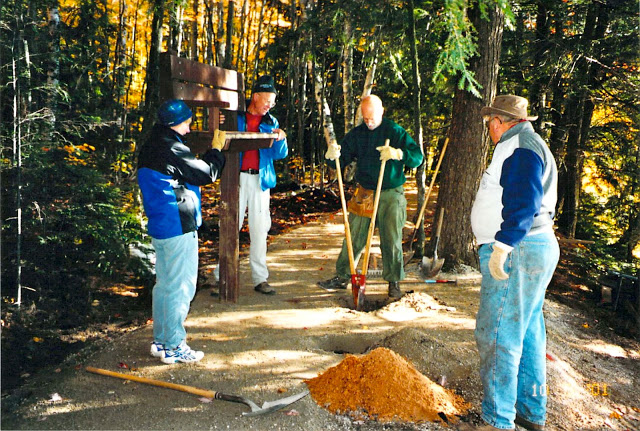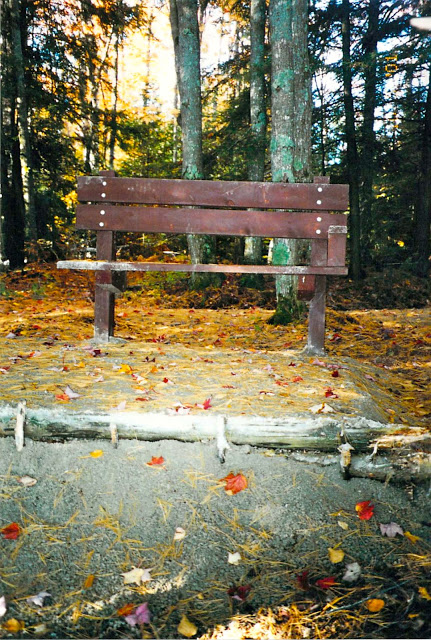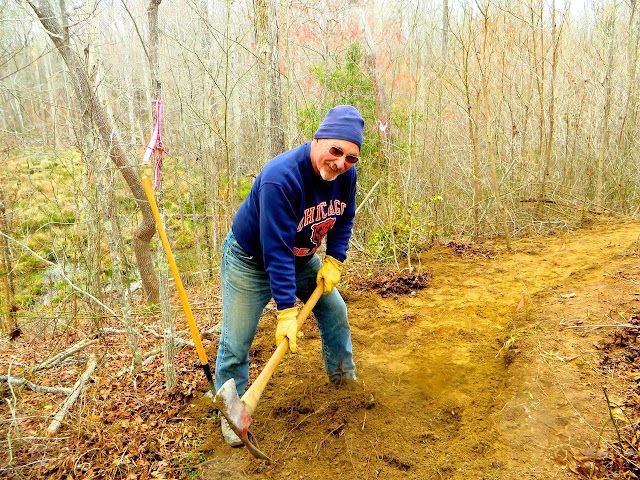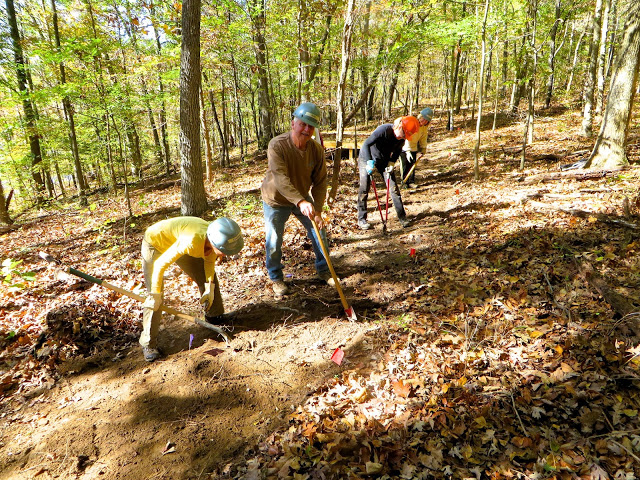Over the last 24 years, I've been participated in 35 volunteer trail projects across the country. Some involved bridge construction, some were maintenance of an existing trail, and some involved the initial construction of the trail or a re-route of a section of existing trail. Here are some examples of my trail construction projects.
In 1998 in Montana's Gallatin National Forest, we rebuilt sections of the Lightning Lake Trail (8000 feet altitude) that had been damaged by horse usage. This photo shows us in the muck installing a culvert to divert water under the trail.
We then constructed what is called a "turnpike," a raised trail section that re-directs water alongside the trail so the tread remains high and dry.
Elsewhere on this same trail, we built a 1/4 mile re-route section to avoid another flood prone area.
In 2000, in Washington's Beacon Rock State Park, we built a lengthy reroute on the Hamilton Mountain Trail to get hikers off an old logging road and into the cooler and more scenic forest. Much of this reroute was on a slope of 45 degrees, making the work a bit trickier.
In 2001, the project was with the Colorado Trail Foundation where we were building the trail across ski slopes of the Copper Mountain Resort at 10,600 feet altitude. The new trail traverses short sections of lovely forest...
...and then crosses ski slopes which are simply meadows in the summer. Few skiers ever see these areas in all their verdant summer glory, and every winter the skiers are unaware the famous Colorado Trail exists below the many feet of snow upon which they are skiing.
Another project in 2001 was in Michigan's Upper Peninsula in the Hiawatha National Forest. The Colwell Lake Trail is a handicap-accessible (ADA) trail which runs for 2.2 miles around the 145 acre Colwell Lake. The gravel trail was actually being built by a crew from a nearby prison, and our crew was following then and installing rest benches on gravel pads. After a pad was laid, we dug holes 42" deep for the bench which we placed in the holes so the set was 19" above the pad. We then leveled and plumbed the bench and filled th holes and tamped, all per ADA requirements.
Here's an example of a finished, wheelchair accessible, ADA approved pad with rest bench. As a final touch on each of the 10 benches we installed, we added some leaves and pine needles to make the rest area look like it had been there for quite some time.
In 2002, the project was for Tennessee's Cumberland State Trail. The trail was already 110 miles in length by then, well on its way to the planned 322 total miles. In case you are curious, the orange vests and caps were required since this section of trail was in the Royal Blue Wildlife Management Area and it was turkey hunting season. Hikers are similarly required to wear orange gear during hunting seasons. To protect ourselves, we wore this orange gear back in camp, too, and yes, we did hear gunshots on occasion.
In order to get a new trail tread of three feet in width on steep slopes like this one, we had to dig out a good deal of the side hill and push all that soil off on the downhill side. We always left a slight tilt to the trail tread so water would run over the edge and off the trail instead of down the trail.
Another 2002 project was Kentucky's Pine Mountain Trail which is projected to be 120 miles long. We dig to remove the loose leaves and duff until we reach compacted dirt so there is a firm trail tread. Of course, the deeper you have to dig, the more rocks and roots you encounter, all of which then have to be removed.
A 2003 project on Arizona's Mogollon Rim's Sinkhole Trail at elevation 7600 feet is located at the Canyon Point Campground. The sinkhole is a centuries old major geologic formation on the Mogollon Rim and a drawing card to the campground, but the trail leading down to its bottom was dangerous and in serious need of rebuilding.
The trail was safe and scenic when we finished!
In 2003, it was South Carolina's Palmetto Trail which is advertised as running "from the mountains to the sea" and 350 miles of the projected 600 mile cross-state trail are complete.
In 2006, my local forest preserve district asked me to built two short trails for their summer day camp programs to use for nature walks. They provided tools and marked the trail corridors with orange flagging...
...and I built the trails, leaving fallen tree trunks and limbs and boulders nearby for instruction by the teachers and examination by the kids...
...and I built a of couple short sections of stairs so disabled kids could safely participate.
Arizona's Hells Canyon Wilderness northwest of Phoenix was a desert project which included a short backpack and a week of desert camping as we repaired and improved the Spring Valley Trail in 2007. Though the area only averages 7 inches of rain each year, the downpours can wreak havoc on the trail features, so we repaired damaged tread and installed water diversion structures.
A finished section of trail with Lake Pleasant visible in the far distance...
In 2009 in Maine's Acadia National Park, we were rebuilding the Great Head Trail which had suffered major damage from several hurricanes. We scoured the hillsides for boulders and large rocks and broke them into smaller pieces with sledgehammers,
...so we could lay a solid bedrock foundation for the new trail...
...and we then covered it with dirt and dug drainage channels on each side of the new trail.
Arkansas' Buffalo River Trail runs 37 miles and our 2002 volunteer crew was led by Ken Smith, the author of the trail's guidebook and a leading local force in creating and completing the trail. In 1972, the Buffalo River was declared the first national river in the United States and is one of the few remaining unpolluted, free-flowing, un-dammed rivers in the lower 48 states and offers both swift-running and placid stretches. I've paddled the river and highly recommend both the trail and a river trip. The trail of course follows the river.
In 2017, we were building re-routes for the Red Leaves Trail in Tennessee's Natchez Trace State Park. Beavers had built a dam which created a wetlands that flooded a lengthy section of trail, so we built a re-route for the trail up on higher ground on the adjacent hillside.
In 2017 in the Shawnee National Forest of Illinois, our host was the Touch of Nature Environmental Center which is an arm of Southern Illinois University which offers outdoor education and adventure programs for both students and adults. We were extending the Ledges Trail which will take hikers to and then alongside Little Grassy Lake which is seen ahead of us in these photos.
Big South Fork National River and Recreation Area in TN was the location for my 2018 project. I had backpacked here with my buddy back in 2000, so this project felt like "payback" for me, a way to give thanks for having provided me a wonderful adventure two decades earlier. I had also vacationed in the Kentucky section of this same park with my sister and her family even before that.


In March of 2020, just as the Corona Virus 19 pandemic was beginning in our country, I was part of a crew of four at Florida's Jupiter Inlet Lighthouse Outstanding Natural Area. On Wednesday of that week, our agency (American Hiking Society) called and said we should go home, that all projects were being cancelled. Our team leader explained that we were housed in a 4 bedroom home on site, we all had private rooms, and all our work was outdoors. Also we were cooking our own meals, so no restaurant visitation was involved. They allowed us to finish the week, which we did, and that was the final trail project of the year for AHS.
We were tasked with helping build a new loop trail through this scrub unique habitat. The mile-long trail corridor had been flagged three weeks earlier, and other groups had cut down the trees and bushes in the new corridor, but they had thrown the cut-offs into the vegetation on both sides of the new trail which would eventually affect the ecology of the area as well as look bad. We pulled this debris onto the trail and then carried, pulled, and used a wheel barrow it get it to the trailhead and then loaded it on a vehicle to be taken for mulching which would then be brought back as the final trail surface. We also had to dig out all the stumps and roots because they were tripping hazards.
Finally, we spread the supply of mulch which was already available, thus completing this section of the trail and showing what the finished trail will soon look like...
My other 16 projects involved bridge building, or trail maintenance where we were lopping overgrowth or removing invasive species, or blocking illegal entry points to an area, or working in a National Park Service greenhouse preparing native plants for transplanting into the wild, or other such activities. The photos and info for all my projects are available here.








































No comments:
Post a Comment